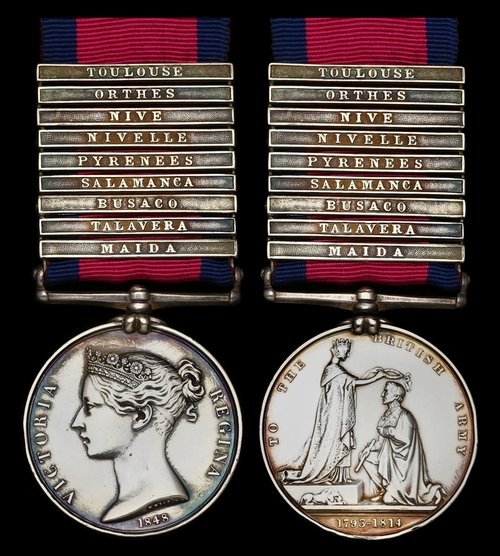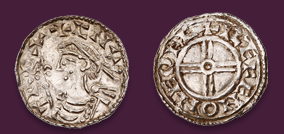
Auction: 25002 - Orders, Decorations and Medals
Lot: 12
(x) The impressive Military General Service Medal awarded to Private J. Green, 61st Regiment of Foot, whose 23-year career with the Colours saw him serve for the entirety of the Peninsula Campaign and afterwards in the West Indies
Military General Service 1793-1814, 9 clasps, Maida, Talavera, Busaco, Salamanca, Pyrenees, Nivelle, Nive, Orthes, Toulouse (Joseph Green, 61st Foot.), edge bruising and a few minor edge knocks, otherwise very fine
Provenance:
Spink, March 1976.
Christie's, November 1990.
This is one of only two medals with this number and combination of clasps issued to the 61st Foot, and the only one awarded to the ranks.
Joseph Green was born circa 1779 in Hartburn, Morpeth in Northumberland. A shoemaker by trade, he enlisted for unlimited service with the 61st Regiment of Foot at Hexham, Northumberland on 16 August 1803 when he was twenty-four years old.
Green would have served in the 1st Battalion of the unit which was embarked for the Italian mainland in June 1806 as part of Major General Sir John Stuart's army. They saw action at the Battle of Maida in Calabria, Italy on 4 July 1806 in Colonel Sir James Kempt's Light Infantry Brigade. There the British fought a decisive victory against the French, inflicting over 1,300 enemy casualties while sustaining only a little over 300 themselves. Soon after the battle, the unit moved to Sicily and then in 1807 were stationed at Gibraltar.
The 61st Foot entered the Peninsula Campaign in Lisbon in June 1809, and were quickly involved in the Battle of Talavera the following month on 28 July. At Talavera the 1st Battalion formed part of the 2nd Brigade under the command of Brigadier General Alan Cameron. After the battle their depleted ranks were reinforced with men from the 2nd Battalion, though it would be a few years until their next major engagement. They fought at the Battle of Salamanca on 22 July 1812 under Major General Hulse's brigade in the 6th Division. Hulse's brigade suffered significant casualties and the 61st Foot was the most hard hit of all - having lost nearly two thirds of its men killed or wounded.
They had some time to recover from such losses, and their next major engagement was not until the Battle of the Pyrenees in July-August 1813 where they experienced a much lower casualty rate. They were back in action again on 10 November at the Battle of the Nivelle and then once more in early December at the Battle of the Nive; consecutive victories which helped the British army push further towards France. Green and the 61st Foot were next engaged at the Battle of Orthes, fought on French soil on 2 February 1814. The battle-worn Regiment was then present at the final major battle of the Peninsula Campaign at Toulouse on 10 April 1814, where they formed part of Lambert's brigade in the 6th Division. During the battle, the 61st Foot's commander Lieutenant-Colonel Robert John Coghlan was killed and all other senior Officers became casualties, leaving the Adjutant and Ensigns to lead the unit out of the battle. Following the abdication of Napoleon and an armistice with the French army, the 61st Foot was moved to Bordeaux.
They remained overseas until disembarking at Ireland in July 1814, and Green continued to serve with the Colours after the defeat of Napoleon. He was to again see overseas service when he was posted to the West Indies on 23 December 1816. The Regiment was stationed in Jamaica for the next six years on garrison duty, and finally returned home on 3 June 1822. Green continued to serve back in England for a further four years, until he was discharged on 3 October 1826 having been ‘worn out and unfit for service in consequence of [?] and length of service’.
His discharge papers cite his conduct as ‘very good’, and note ‘He served at the battle of Maida and during the whole of the campaign in the Peninsula, and was present at the battles of Talavera, Salamanca, Pyrenees, Nivelle, Nive, Orthes and Toulouse’. Upon his discharge, Green was forty-seven years old and had served for over 23 years. He received a pension and intended to return up north. Green later died on 6 December 1852 at the age of 75, until which time he had been residing at Newcastle; sold together with copied medal roll and discharge papers.
Subject to 5% tax on Hammer Price in addition to 20% VAT on Buyer’s Premium.
Sold for
£6,000
Starting price
£1600




